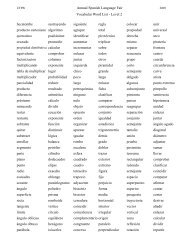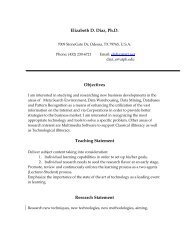WORKSHEET 12 HOMEWORK MATH 2414 Calculus 2 Brian Hagler ...
WORKSHEET 12 HOMEWORK MATH 2414 Calculus 2 Brian Hagler ...
WORKSHEET 12 HOMEWORK MATH 2414 Calculus 2 Brian Hagler ...
You also want an ePaper? Increase the reach of your titles
YUMPU automatically turns print PDFs into web optimized ePapers that Google loves.
<strong>WORKSHEET</strong> <strong>12</strong> <strong>HOMEWORK</strong><strong>MATH</strong> <strong>2414</strong> <strong>Calculus</strong> 2<strong>Brian</strong> <strong>Hagler</strong>Worksheet <strong>12</strong>: Convergence and Divergence for Sequences and SeriesProblems11. Place each sequence in its classification region in the ”Happy Land of Sequences” diagram. (γ is Euler’sconstant, f n is the Fibonacci sequence, and g n is the golden ratio sequence.)(a) ( n 2) ∞(b) (( )− 1 n ) ∞n=03(c) (γ n ) ∞ n=0n=0(d) (n + 2(−1) n ) ∞ n=0(e) ((−1) n f n ) ∞ n=0(f) (g n ) ∞ n=0(g)((−3) n ) ∞ n=0(h) (2 cos(nπ)) ∞ n=0(i) (n + n(−1) n ) ∞ n=0(j) ( 1 ∞n!)n=0<strong>12</strong>. Show that (( 1 + n) 1 n ) ∞is a monotone increasing sequence bounded below by 2 and above by 3.n=1 (Explain why can we conclude that lim n→∞ 1 +1 nn)exists and is a real number between 2 and 3 (which we,by the way, call Euler number e).13. Justify each equality in the following sketch of the proof that n 1 n → 1:lim n 1 n = limn→∞ n→∞ eln n 1 n14. Find the sequence limit. (g is the golden ratio.)(a) √ n(f) ( 15= limn→∞ e 1 n ln n = e limn→∞( 1 n ln n) = e 0 = 1.(b) √ nln n(c) n − √ n 2 + 1 (d) √ n − n (e) 2 1/n) 1/n(g) n2n!(h) 3nn(i) n 3 − 2 n (j) (−γ)n3(k) (−π/g) n (l) n!n n(m) e n1−2n (n) e n!−2n (o) ( 1 + 1 ne n) 2n15. Classify as divergent, conditionally convergent or absolutely convergent. Indicate the test you used.(a) ∑ <strong>12</strong>(b) ∑ 1n(c) ∑ (−1) nn(d) ∑ ( )1 n2(e) ∑ 1n 2(f) ∑ (−1) n nln n(g) ∑ (−1) n n 22 n (h) ∑ (−1) n n!n 10(k) ∑ 4 nn!(l) ∑ n 3 2 −n (m) ∑ (−3) n2 n (n) ∑ n!n n(p) ∑ (−1) n√ n(q) ∑ (−1) nn 2 +1(r) ∑ n 2 +n+1n 3 −2n−2(i) ∑ (−1) nln n(j) ∑ (−1) n+1(o) ∑ ( 4n 2 +n−13n 2 +n−1n!) n(s) ∑ cos nπ2n−1(t) ∑ 13n+2 nSelected Answers to Problems<strong>12</strong>. The Binomial Theorem gives(1 + 1 ) n= 1 + n 1n 1 n+n(n − 1)2!which with a little algebra can be written as1 + 1 + 1 (1 − 1 )+ 1 (1 − 1 2! n 3! n) (1 − 2 n1 n(n − 1)(n − 2) 1+n2 3! n 3 + · · · + n! 1n! n n ,)+ · · · + 1 (1 − 1 ) (1 − 2 ) (· · · 1 − n − 1 ).n! n nnFrom this one can conclude that the sequence is increasing and that(2 ≤ 1 + 1 ) n≤ 1 + 1 + 1 n2 + 1 2 2 + · · · + 1 < 3.2n−1 13. The first equality follows from n 1 n = e ln n 1 n, the second from ln n 1 n = 1 nln n, the third by continuity ofthe exponential function, the fourth since ln n ≪ n, and the last is just algebra.14. (a) ∞ (b) ∞ (c) 0 (d) −∞ (e) 1 (f) 1 (g) 0 (h) ∞ (i) −∞ (j) 0 (k) dne (l) 0 (m) e −1/2(n) ∞ (o) e 215. (a) divergent by n-th term test (b) divergent by integral test (c) conditionally convergent: convergentby alternating series test, but not absolutely convergent by comparison to the harmonic series. (d) absolutelyconvergent since it’s a geometric series with ratio 1/2 (e) absolutely convergent since it’s a p-series
<strong>WORKSHEET</strong> <strong>12</strong> <strong>HOMEWORK</strong>with (f) divergent by n-th term test (g) absolutely convergent by ratio test (h) divergent by n-th termtest (i) conditionally convergent: convergent by alternating series test, but not absolutely convergent bycomparison to the harmonic series. (j) absolutely convergent by ratio test (k) absolutely convergent byratio test (l) absolutely convergent by ratio test (m) divergent by n-th term test (n) absolutely convergentby ratio test (o) divergent by root test (p) conditionally convergent: convergent by alternatingseries test, but not absolutely convergent by comparison to the p-series with p = 1/2. (q) absolutelyconvergent by limit comparison to p-series with p = 2 (r) divergent by limit comparison to Harmonic series(s) conditionally convergent: convergent by alternating series test, but not absolutely convergent by limitcomparison to the harmonic series. (t) absolutely convergent by comparison to the geometric series withratio 1/2








